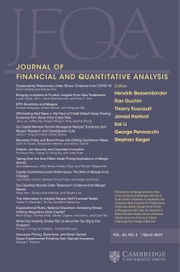Article contents
How Can Innovation Screening Be Improved? A Machine Learning Analysis with Economic Consequences for Firm Performance
Published online by Cambridge University Press: 28 March 2025
Abstract
This study utilizes U.S. Patent Office data to explore potential improvements in the patent examination process through machine learning. It shows that integrating machine learning with human expertise can increase patent citations by up to 26%. Using machine learning predictions as benchmarks, I find that the early expiration rate of granted patents positively correlates with examiners’ false acceptance rates. These errors negatively impact public companies’ operational performance and reduce successful IPO or M&A exits for private firms. Overall, this study highlights significant social and economic benefits of incorporating machine learning as a robo-advisor in patent screening.
Information
- Type
- Research Article
- Information
- Creative Commons
- This is an Open Access article, distributed under the terms of the Creative Commons Attribution licence (http://creativecommons.org/licenses/by/4.0), which permits unrestricted re-use, distribution and reproduction, provided the original article is properly cited.
- Copyright
- © The Author(s), 2025. Published by Cambridge University Press on behalf of the Michael G. Foster School of Business, University of Washington
Footnotes
I am grateful to Kai Li (the editor) and an anonymous referee for the constructive comments in the review process. I also thank Thomas Chemmanur, Francesco D’Acunto, Ran Duchin, Slava Fos, Edith Hotchkiss, Seung Jung Lee, Svetlana Petrova, Jonathan Reuter, Alberto Rossi, Yiming Qian, Ronnie Sadka, Philip Strahan, Wanli Zhao, and conference participants at the 2022 American Economic Association Annual Meeting, the 2020 Doctoral Consortium of the Financial Management Association Annual Meeting, the 2020 Southern Finance Association Annual Meeting, the 2021 Eastern Finance Association Annual Meeting, the 2021 Financial Management Association Annual Meeting, the 2022 Midwest Finance Association Annual Meeting, and seminar participants at Boston College, California State University at Fullerton, Chinese University of Hong Kong (Hong Kong & Shenzhen), City University of Hong Kong, Durham University, Fudan University, Georgetown University Global Virtual Seminar Series on Fintech, Luohan Academy, Oregon State University, Peking University, San Diego State University, Shanghai Jiaotong University, Shanghai University of Finance and Economics, University of Connecticut, and University of Florida for helpful comments. Any errors and omissions remain my own responsibility.
References
- 1
- Cited by

